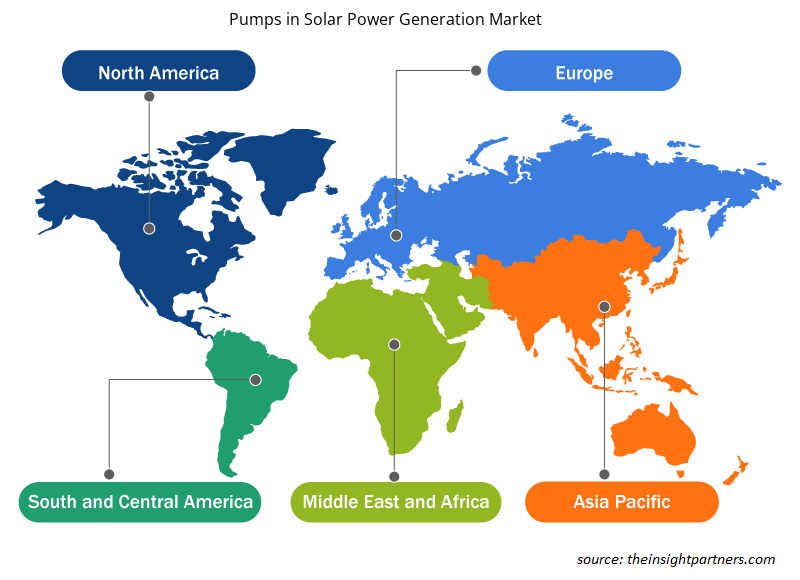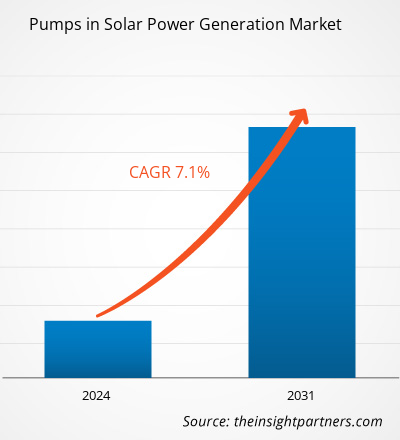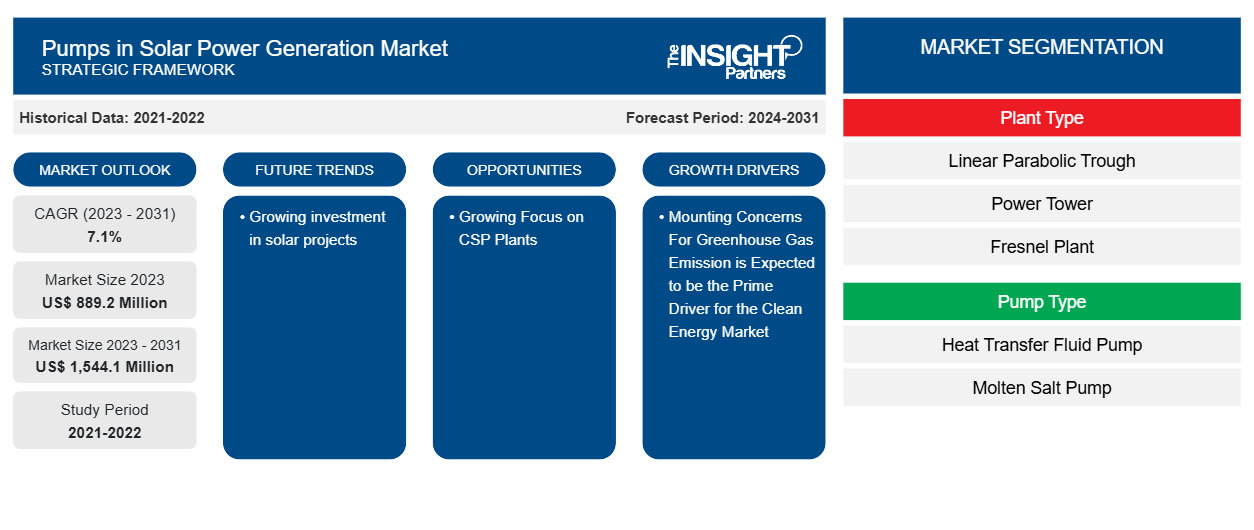太阳能发电泵市场规模预计将从 2023 年的 8.892 亿美元增至 2031 年的 15.441 亿美元。预计 2023-2031 年期间市场复合年增长率将达到 7.1%。可再生能源需求的不断增长以及政府对清洁能源发展的日益重视,是太阳能发电泵市场的主要推动力。
太阳能发电泵市场分析
预计在预测期内,电力需求增长、政府支持政策以及全球范围内可再生能源的实施将推动太阳能发电泵市场的增长。然而,安装的高昂设置成本可能会对太阳能发电泵市场产生负面影响。
太阳能发电泵市场概况
太阳能发电厂数量的增长预计将增加对太阳能系统中加热传输流体所需的泵的需求。在预测期内,对可再生能源在整体电力结构中所占份额的日益关注预计将推动太阳能发电市场泵的增长。
定制此报告以满足您的需求
您可以免费定制任何报告,包括本报告的部分内容、国家级分析、Excel 数据包,以及为初创企业和大学提供优惠和折扣
-
获取此报告的关键市场趋势。这个免费样品将包括数据分析,从市场趋势到估计和预测。
太阳能发电泵市场驱动因素和机遇
温室气体排放问题日益严重
《巴黎协定》于 2015 年启动,并于 2016 年生效,此后,能源系统的发展刺激了清洁能源的使用,从而降低了碳排放。导致气候变化的温室气体排放的一个主要因素是利用化石燃料发电。由于人们越来越关注更可持续和更环保的能源替代品,太阳能的使用量正在增长。此外,日益增长的气候变化问题和政府的支持性举措正在推动全球太阳能的使用。因此,预计在预测期内,各国政府减轻环境污染程度的议程将推动太阳能发电市场泵的增长。
CSP 电厂日益受到关注
美国、中国和南非等国家的政府和组织越来越重视对先进技术的投资,以提高太阳能发电厂的运营效率。聚光太阳能 (CSP) 发电厂利用镜子将日光反射并集中到接收器上,接收器会积累光能并将其转化为热能或热量。不同行业对能源的需求不断增长,以及对环境污染的日益担忧,促使全球范围内部署了 CSP 系统。此外,政府采取可持续方式减少碳排放的有利举措以及可再生能源行业发展的兴起,正在推动对 CSP 发电厂的投资,从而推动太阳能发电市场的发展。
太阳能发电泵市场报告细分分析
在太阳能发电市场分析中,有助于得出泵的关键部分是工厂类型和泵类型。
- 根据工厂类型,太阳能发电市场的泵分为线性抛物线槽、电力塔和菲涅尔电厂。线性抛物线槽部分在 2023 年占据了最大的市场份额。
- 根据泵类型,市场细分为导热流体泵和熔盐泵。导热流体泵细分市场在 2023 年占据市场主导地位。
太阳能发电泵市场份额按地区分析
太阳能发电市场报告中泵的地理范围主要分为五个区域:北美、欧洲、亚太、中东和非洲、南美和中美。
2023 年,亚太地区在太阳能发电市场中占据主导地位。亚太地区的市场分为澳大利亚、中国、印度、日本和韩国。人口增长和能源需求增加是推动亚太地区太阳能市场发展的主要因素。日益严重的环境污染和严峻的气候变化影响是刺激对可再生替代能源的需求以降低化石燃料使用量的主要问题。
因此,人们对太阳能的日益关注以及减少对化石燃料依赖和碳排放的支持措施和政府政策预计将推动亚太地区太阳能发电市场泵的增长。
太阳能发电泵市场区域洞察
Insight Partners 的分析师已详细解释了预测期内影响太阳能发电泵市场的区域趋势和因素。本节还讨论了北美、欧洲、亚太地区、中东和非洲以及南美和中美洲的太阳能发电泵市场细分和地理位置。

- 获取太阳能发电市场泵的区域特定数据
太阳能发电泵市场报告范围
| 报告属性 | 细节 |
|---|---|
| 2023 年的市场规模 | 8.892 亿美元 |
| 2031 年市场规模 | 15.441亿美元 |
| 全球复合年增长率(2023 - 2031) | 7.1% |
| 史料 | 2021-2022 |
| 预测期 | 2024-2031 |
| 涵盖的领域 |
按植物类型
|
| 覆盖地区和国家 |
北美
|
| 市场领导者和主要公司简介 |
|
太阳能发电泵市场参与者密度:了解其对业务动态的影响
太阳能发电泵市场正在快速增长,这得益于终端用户需求的不断增长,而这些需求又源于消费者偏好的不断变化、技术进步以及对产品优势的认识不断提高等因素。随着需求的增加,企业正在扩大其产品范围,进行创新以满足消费者的需求,并利用新兴趋势,从而进一步推动市场增长。
市场参与者密度是指在特定市场或行业内运营的企业或公司的分布情况。它表明相对于给定市场空间的规模或总市场价值,有多少竞争对手(市场参与者)存在于该市场空间中。
在太阳能发电泵市场运营的主要公司有:
- 荏原制作所
- 福斯公司
- 格兰富
- 基洛斯卡兄弟有限公司
- KSB SE&KGaA公司
免责声明:上面列出的公司没有按照任何特定顺序排列。

- 了解太阳能发电泵市场的主要参与者概况
太阳能发电泵市场新闻及最新发展
通过收集一手和二手研究后的定性和定量数据来评估太阳能发电市场的泵,其中包括重要的公司出版物、协会数据和数据库。以下列出了太阳能发电市场泵的一些发展情况:
- 天合光能与 Aquila Clean Energy 签署了 800MW 光伏组件供应框架协议。(来源:天合光能,新闻稿/公司网站/通讯,2023 年 7 月)
- 天合光能为中国四川省西固和斜卡混合水电厂供应了 463.18MW Vertex 580W 组件。这些组件可提供更高的串功率、更大的系统容量和更高的能量产量。(来源:天合光能,新闻稿/公司网站/通讯,2023 年 7 月)
太阳能发电泵市场报告范围和交付成果
“太阳能发电泵市场规模及预测(2021-2031)”报告对以下领域进行了详细的市场分析:
- 太阳能发电泵市场规模及预测,涵盖范围内所有关键细分市场的全球、区域和国家层面
- 太阳能发电泵市场趋势以及市场动态,如驱动因素、限制因素和关键机遇
- 详细的 PEST/波特五力分析和 SWOT 分析
- 太阳能发电泵市场分析涵盖关键市场趋势、全球和区域框架、主要参与者、法规和最新市场发展
- 行业格局和竞争分析,涵盖市场集中度、热图分析、知名参与者以及太阳能发电市场泵的最新发展
- 详细的公司简介
- 历史分析(2 年)、基准年、预测(7 年)及复合年增长率
- PEST和SWOT分析
- 市场规模、价值/数量 - 全球、区域、国家
- 行业和竞争格局
- Excel 数据集
近期报告
相关报告
客户评价
购买理由
- 明智的决策
- 了解市场动态
- 竞争分析
- 客户洞察
- 市场预测
- 风险规避
- 战略规划
- 投资论证
- 识别新兴市场
- 优化营销策略
- 提升运营效率
- 顺应监管趋势























 获取免费样品 - 太阳能发电市场中的泵
获取免费样品 - 太阳能发电市场中的泵